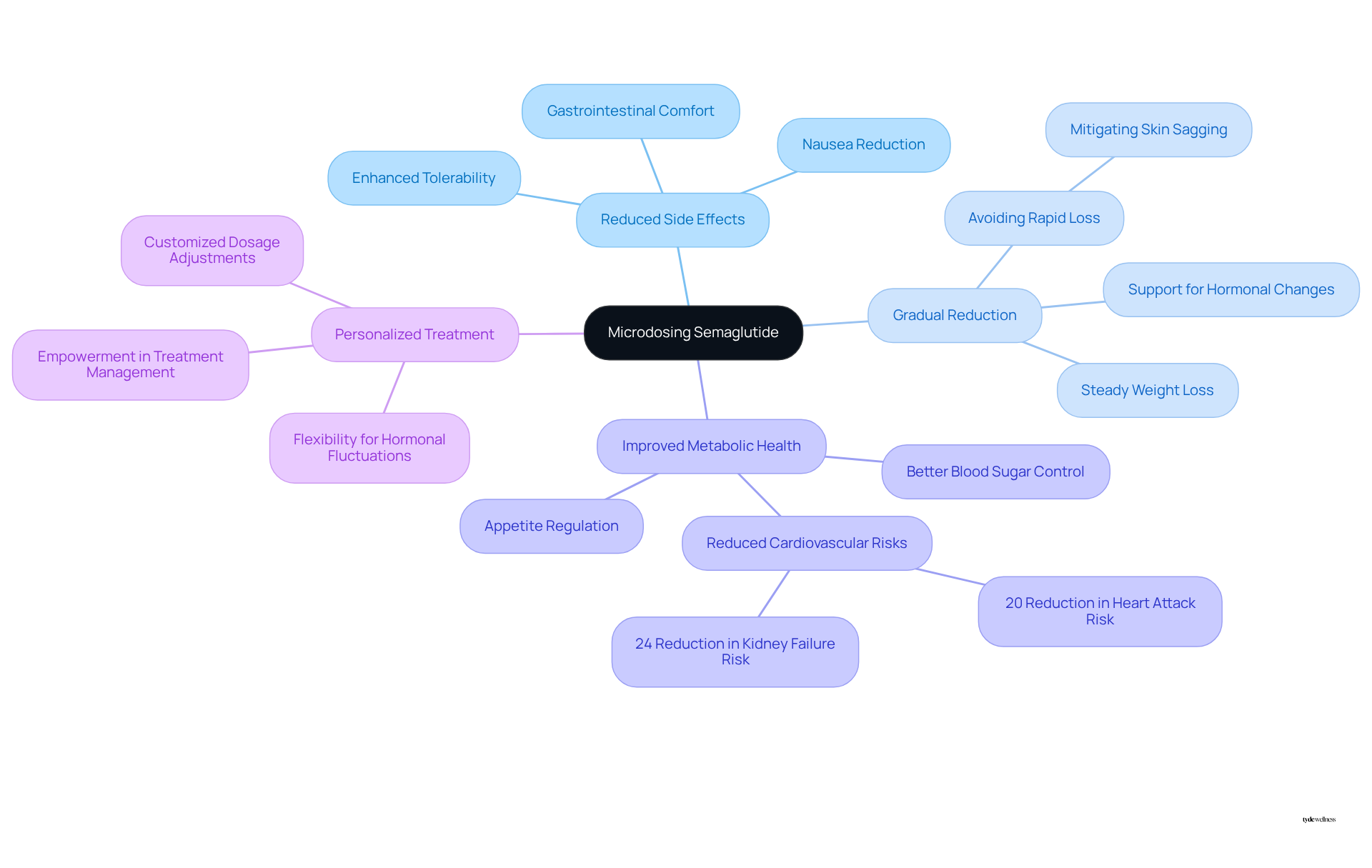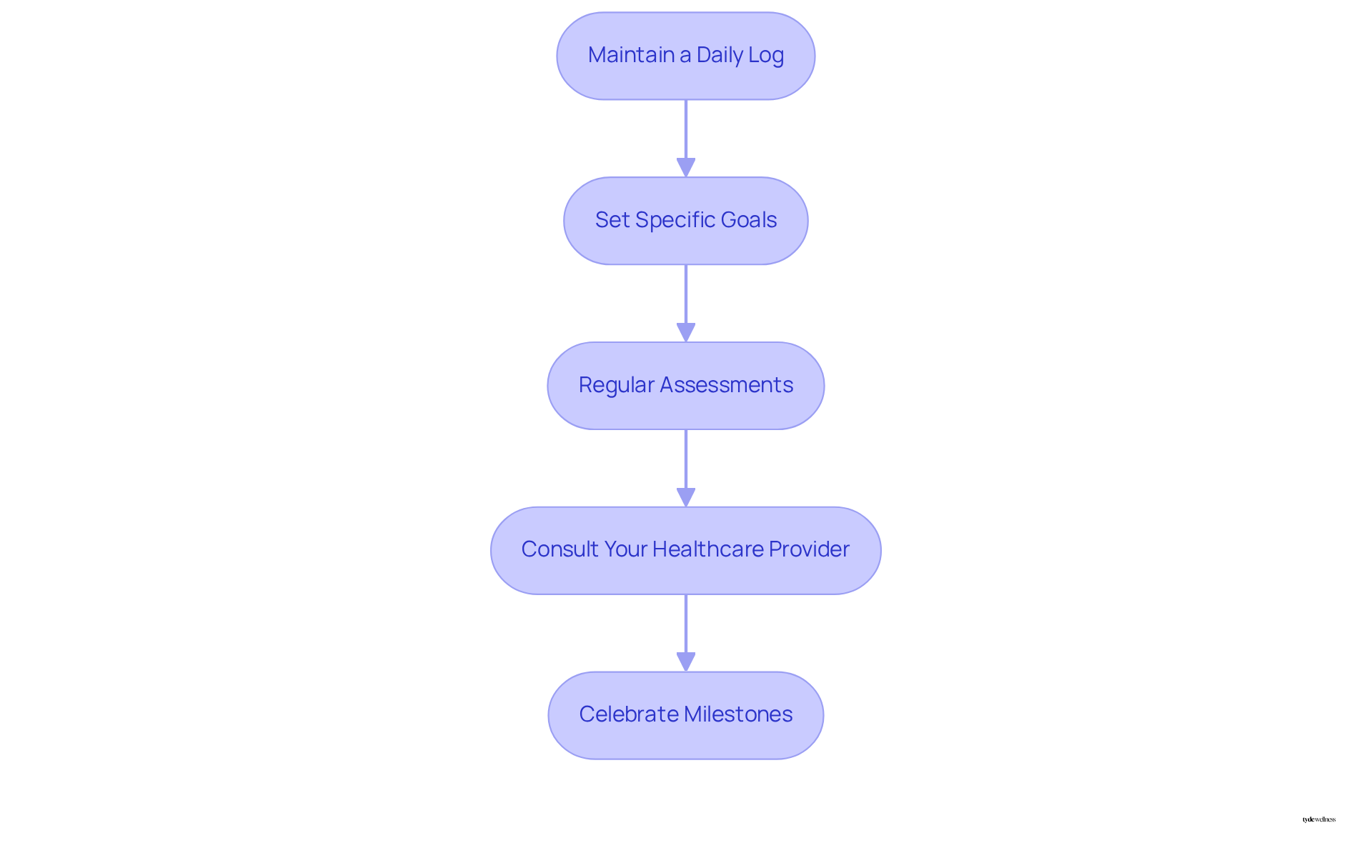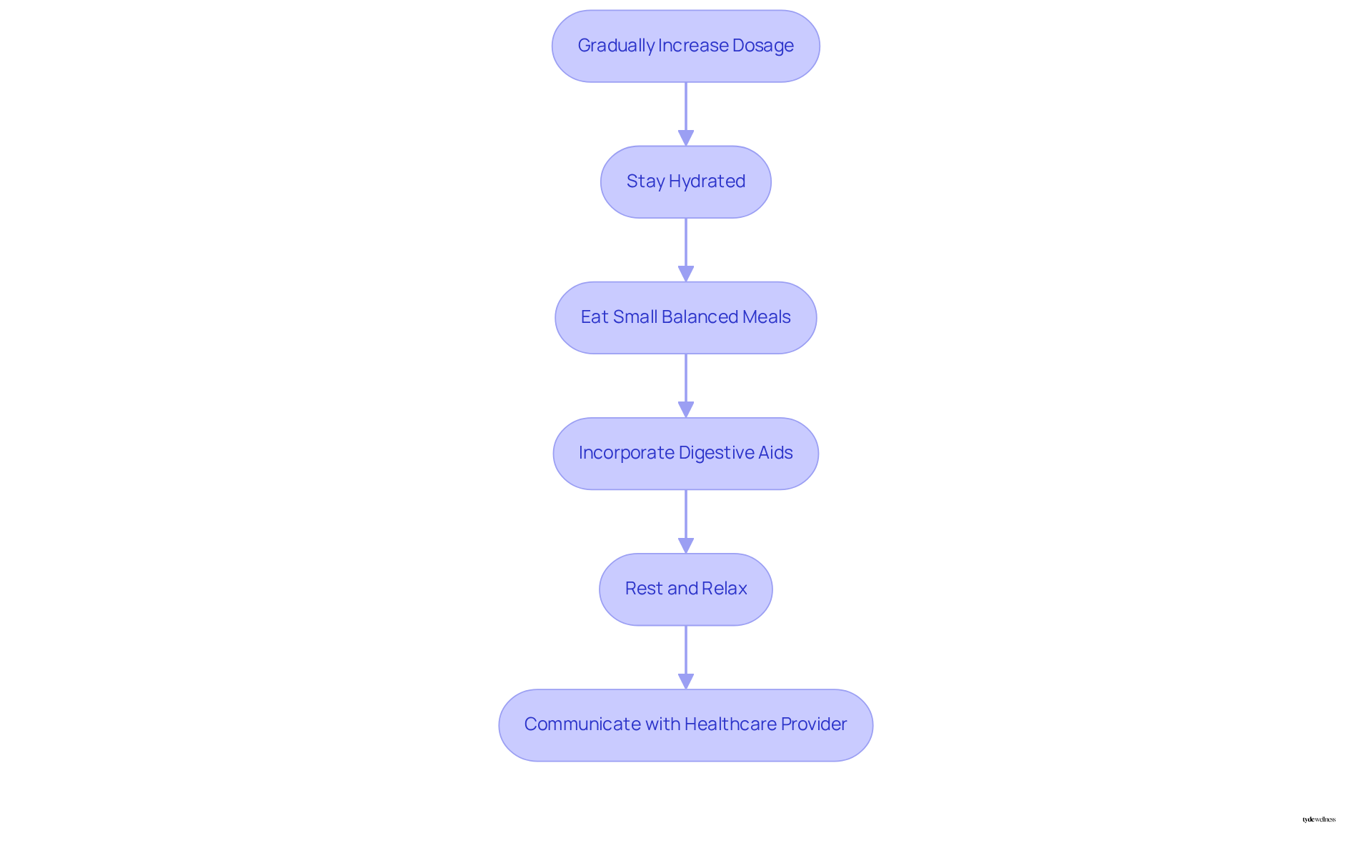Overview
Microdosing semaglutide consists of administering smaller doses of the medication, which helps to minimize side effects and enhance tolerability, especially for women undergoing hormonal changes. This article provides a step-by-step guide that underscores the importance of:
- Consulting healthcare providers
- Tracking progress
- Adjusting dosages
Collectively, these steps aim to ensure safer and more effective weight management.
Introduction
Microdosing semaglutide offers a distinctive method for managing weight and metabolic health, especially for women experiencing hormonal changes. This approach involves administering smaller doses, which may help minimize side effects while allowing individuals to embark on a more gradual and sustainable path toward their health objectives.
However, the absence of endorsement from regulatory bodies raises significant concerns regarding the safety and efficacy of this practice.
What strategies can women adopt to effectively microdose semaglutide, ensuring they minimize risks while maximizing benefits?
Understand Microdosing Semaglutide: Key Concepts and Benefits
Microdosing semaglutide involves administering smaller-than-usual doses of the medication, which allows for a gradual adaptation to its effects. This method can help alleviate common side effects associated with higher doses, such as nausea and gastrointestinal discomfort. The benefits of microdosing are noteworthy:
- Reduced Side Effects: Lower doses can result in fewer adverse reactions, enhancing the treatment’s tolerability. Kenneth Fill, PharmD, observes that “Microdosing seems to tone down these adverse reactions,” providing reassurance for those concerned about discomfort.
- Gradual Reduction: This approach supports a more regulated path toward weight loss, particularly beneficial for women undergoing hormonal changes. Research shows that participants who microdose may experience steady weight loss over time, thereby avoiding the rapid loss that can lead to aesthetic issues like skin sagging.
- Improved Metabolic Health: By fine-tuning the dosage, individuals may achieve better blood sugar control and appetite regulation. Studies indicate that semaglutide can enhance metabolic outcomes, with smaller doses potentially amplifying these benefits. Notably, semaglutide reduces the risk of heart attack, stroke, or heart-related death by 20%, underscoring its broader health advantages.
- Personalized Treatment: Microdosing provides a customized approach, enabling women to adjust their intake according to their specific responses and needs. This flexibility is vital for those experiencing hormonal fluctuations, as it empowers them to manage their treatment effectively.
However, it is crucial to recognize that the FDA and Novo Nordisk do not endorse the small-dose administration of semaglutide due to insufficient clinical trials validating its effectiveness and safety. Understanding these aspects is essential for women considering this method as part of their management strategy, especially during significant life stages like perimenopause and menopause.

Establish Your Microdosing Plan: Dosage and Schedule
To establish an effective microdosing plan for semaglutide, follow these essential steps:
-
Consult with a Healthcare Provider: Before starting any small-dose regimen, it is essential to discuss your health history and weight loss objectives with a qualified healthcare professional. This ensures that microdosing is suitable for your individual circumstances and helps mitigate potential risks associated with unsupervised use.
-
Determine Initial Dosage: Begin with a conservative dose, such as 0.05 mg weekly. This low initial level enables your body to slowly adjust to the medication, reducing the chances of negative reactions.
-
Create a Schedule: Develop a structured dosing schedule to guide your progress. For instance:
- Weeks 1-4: 0.05 mg weekly
- Weeks 5-8: Increase to 0.1 mg weekly
- Weeks 9-12: Increase to 0.2 mg weekly
- Adjust further based on your response and the guidance of your healthcare provider.
-
Track Your Dosage: Maintain a detailed log of your doses and any side effects experienced. Utilizing a journal or a dedicated app can facilitate this process, enabling you to make informed adjustments as needed.
-
Regular Check-ins: Schedule consistent follow-up appointments with your healthcare provider to evaluate your progress. These check-ins are essential for assessing the effectiveness of your microdosing strategy and making necessary adjustments to enhance your journey toward achieving a healthier body.
Experts caution against self-administering microdoses without professional oversight, as this practice can lead to unexpected complications and reduced effectiveness. Following a structured plan under medical guidance not only improves safety but also aligns with the objective of attaining sustainable reduction in body mass. Notably, participants in Tyde Wellness programs often experience weight loss exceeding 20-25% within a year, with an average body weight loss of 15% reported after 68 weeks of Wegovy treatment. Additionally, using one-fifth of the standard initial dose can significantly reduce costs from $250 per week to $50 per week, making this approach more financially accessible.
![]()
Monitor Your Progress: Adjusting Dosage and Tracking Results
Tracking your progress is essential for enhancing your experience with semaglutide. Here’s how to effectively track your results:
-
Maintain a Daily Log: Document your daily dosage, any reactions, and your general mood and energy levels. This practice helps identify patterns and responses to the medication, providing valuable insights into your journey.
-
Set Specific Goals: Clearly define your objectives with small-dose usage, such as particular weight loss targets or increased energy levels. Establishing these benchmarks allows you to measure your progress effectively.
-
Regular Assessments: Conduct a review of your journal entries every four weeks to evaluate your progress against your goals. Take into account elements like weight fluctuations, appetite regulation, and any reactions encountered during this time.
-
Consult Your Healthcare Provider: It is essential to have medical supervision while using small doses. If you experience considerable adverse reactions or find that you are not achieving your desired results, consult your healthcare provider to discuss possible dosage modifications. For instance, if you began with a dose of 0.05 mg and feel comfortable, you might consider increasing it to 0.1 mg.
-
Celebrate Milestones: Recognize and celebrate your achievements, regardless of their size. Acknowledging these milestones will assist in maintaining your motivation and dedication throughout your journey with small doses.
Caution: Microdosing has not been extensively researched, and its effectiveness is not well established. Always proceed with caution and under the guidance of your healthcare team to ensure safe practices. As Dr. Jennie Stanford notes, adjusting dosages without proper medical guidance can introduce new risks and render treatment ineffective.

Manage Side Effects: Tips for a Smooth Microdosing Experience
To manage side effects effectively while microdosing semaglutide, consider the following strategies.
-
Begin gradually by slowly raising your dosage. This approach allows your body to adapt, which can reduce the likelihood of significant adverse reactions.
-
Stay hydrated by drinking plenty of water. Adequate hydration can help alleviate gastrointestinal discomfort and support your overall health.
-
Eating small, balanced meals is also beneficial. Consuming smaller portions can help mitigate nausea and other digestive issues. Initially, focus on bland, low-fat foods to ease your digestive system.
-
Incorporate digestive aids, such as ginger tea or peppermint, to soothe your stomach if you experience nausea. These natural remedies can provide relief during your microdosing journey.
-
Rest and relaxation play a crucial role in managing side effects. Ensure you get adequate rest and engage in relaxation techniques, such as deep breathing or yoga, to help manage stress and enhance your overall well-being.
-
Finally, maintain open communication with your healthcare provider. Discuss any side effects you experience, as they can offer additional strategies or adjust your plan as necessary.

Conclusion
Microdosing semaglutide offers a promising strategy for women aiming to enhance their weight loss journey while effectively managing side effects. By employing smaller doses, individuals can experience a gradual adaptation to the medication, which may lead to a reduction in adverse reactions and improved overall treatment tolerability. This approach not only fosters sustainable weight loss but also facilitates a personalized treatment plan that aligns with the unique hormonal changes many women encounter.
Key insights throughout the article underscore the necessity of:
- Consulting healthcare professionals
- Establishing a structured dosing schedule
- Diligently tracking progress
Initiating treatment with a conservative dosage and progressively adjusting based on individual responses can contribute to improved metabolic health and greater overall wellness. Furthermore, managing side effects through hydration, diet, and open communication with healthcare providers can significantly enhance the microdosing experience.
Ultimately, adopting the concept of microdosing semaglutide empowers women to take control of their health in a safe and effective manner. As research continues to evolve, it remains essential to stay informed and cautious, ensuring that any microdosing regimen is approached with professional guidance. By prioritizing health and well-being, women can navigate their weight loss journey with confidence and clarity, making informed decisions that resonate with their personal goals.
Frequently Asked Questions
What is microdosing semaglutide?
Microdosing semaglutide involves administering smaller-than-usual doses of the medication, allowing for a gradual adaptation to its effects and potentially reducing common side effects.
What are the benefits of microdosing semaglutide?
The benefits include reduced side effects, a gradual reduction in weight, improved metabolic health, and a personalized treatment approach.
How does microdosing help with side effects?
Lower doses can lead to fewer adverse reactions, enhancing the treatment’s tolerability and alleviating issues such as nausea and gastrointestinal discomfort.
How does microdosing support weight loss?
Microdosing supports a more regulated path toward weight loss, particularly for women undergoing hormonal changes, resulting in steady weight loss and avoiding rapid loss that can cause skin sagging.
What impact does microdosing have on metabolic health?
Microdosing may improve blood sugar control and appetite regulation, with studies indicating that semaglutide can enhance metabolic outcomes and reduce the risk of heart attack, stroke, or heart-related death by 20%.
Why is personalized treatment important in microdosing?
Personalized treatment allows individuals to adjust their intake based on specific responses and needs, which is especially important for those experiencing hormonal fluctuations.
Is microdosing semaglutide endorsed by health authorities?
No, the FDA and Novo Nordisk do not endorse the small-dose administration of semaglutide due to insufficient clinical trials validating its effectiveness and safety.
List of Sources
- Understand Microdosing Semaglutide: Key Concepts and Benefits
- The Wonderful Benefits of Microdosing Semaglutide for Midlife Women – Top Doctor Magazine (https://topdoctormagazine.com/wellness/the-wonderful-benefits-of-microdosing-semaglutide-for-midlife-women)
- Microdosing Semaglutide: A Guide to Dosing & Benefits (https://buycanadianinsulin.com/microdosing-semaglutide)
- Ozempic Microdosing: Benefits, Risks, and Effectiveness (https://healthline.com/health-news/ozempic-microdosing-weight-loss)
- Microdosing weight-loss drugs is on the rise – but does it work? (https://newscientist.com/article/mg26535364-200-microdosing-weight-loss-drugs-is-on-the-rise-but-does-it-work)
- Microdosing: how ‘off-label’ use of weight loss jabs is spreading from US to UK (https://theguardian.com/business/2025/jul/12/microdosing-weight-loss-jabs-off-label-glp-1-mountjaro)
- Establish Your Microdosing Plan: Dosage and Schedule
- Does microdosing Ozempic work? What are experts saying about diabetes drug also used for weight loss? (https://bouve.northeastern.edu/news/does-microdosing-ozempic-work-what-are-experts-saying-about-diabetes-drug-also-used-for-weight-loss)
- Does microdosing Ozempic work? (https://singlecare.com/blog/microdosing-ozempic)
- Does Microdosing Ozempic Work? Know the Benefits & Risks (https://buzzrx.com/blog/microdosing-ozempic)
- Microdosing Ozempic? Why some people are playing doctor with weight-loss drugs (https://latimes.com/lifestyle/story/2024-11-05/microdosing-ozempic-weight-loss-drugs-diy-dosage)
- Is Ozempic Microdosing Safe? Experts Advise Caution (https://recovered.org/blog/ozempic-microdosing-glp1hack)
- Monitor Your Progress: Adjusting Dosage and Tracking Results
- Forget Psychedelics. Everyone’s Microdosing Ozempic Now (https://hollywoodreporter.com/lifestyle/lifestyle-news/microdosing-ozempic-weight-loss-health-gains-1236126989)
- People are ‘microdosing’ Ozempic — and doctors have a surprising stance on whether it’s healthy (https://nypost.com/2024/09/28/health/people-are-microdosing-ozempic-and-doctors-have-a-surprising-stance-on-whether-its-healthy)
- People are ‘microdosing’ weight-loss drugs. A GP explains what to watch out for (https://theconversation.com/people-are-microdosing-weight-loss-drugs-a-gp-explains-what-to-watch-out-for-253955)
- Is Ozempic Microdosing Safe? Experts Advise Caution (https://recovered.org/blog/ozempic-microdosing-glp1hack)
- Comment on Komé et al. One Size Does Not Fit All: Understanding Microdosing Semaglutide for Diabetes in Multidose Pens (https://diabetesjournals.org/care/article/48/7/e93/160621/Comment-on-Kome-et-al-One-Size-Does-Not-Fit-All)
- Manage Side Effects: Tips for a Smooth Microdosing Experience
- Microdosing Ozempic: How it works, benefits, and risks (https://medicalnewstoday.com/articles/drugs-microdosing-ozempic)
- Does microdosing Ozempic work? (https://singlecare.com/blog/microdosing-ozempic)
- Is ‘Microdosing’ Ozempic Safe? (https://verywellhealth.com/microdosing-ozempic-11700678)
- Ozempic Microdosing: Benefits, Risks, and Effectiveness (https://healthline.com/health-news/ozempic-microdosing-weight-loss)